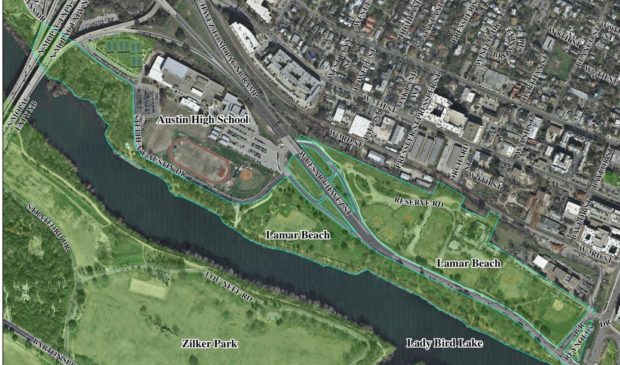Lamar Beach Master Plan coming together
Friday, October 28, 2016 by
Jack Craver Members of the City Council Open Space, Environment and Sustainability Committee expressed delight Wednesday at the consensus among stakeholders over the Lamar Beach Master Plan, a proposed multimillion-dollar overhaul of Lamar Beach at Town Lake Metropolitan Park.
Representatives of the West Austin Youth Association (WAYA), Austin Pets Alive! and Austin High School, all of which make use of the current park facilities, spoke in favor of moving forward on the master plan.
Council Member Delia Garza joked that Council would appreciate if the “master mind” who brought all the groups together could help develop a similar consensus on the Grove at Shoal Creek, a deeply divisive development proposal in West Austin.
Plans to extend Pressler Street into the park initially threatened to stall support for the project.
But the new plan recommended by the Parks and Recreation Department instead calls for a smaller extension of Pressler and a dramatic realignment of Cesar Chavez Street, which currently snakes through the park, so that the two roads intersect just north of the park.
Austin High School Principal Amy Taylor noted that the school had been reluctant to endorse the proposal in the past because of the original plans for Pressler. However, she is able to support the new vision, she said.
Access to the park is critical to the school, which has only 30 acres of outdoor recreation space compared to a national average of 100, said Taylor. Austin High students rely on the park’s tennis courts, baseball fields and other facilities.
“Lamar Beach partnering with Austin High is a valuable, valuable relationship,” Taylor said.
Melissa Morrow, executive director of WAYA, told the committee that it took a great deal of work to develop a plan that was palatable to the variety of groups with an interest in the land.
“Definitely at the beginning, we were all fighting for our piece of it,” she said.
Two years ago, Morrow said, she never would have guessed that city staff would be able to facilitate agreement among the groups and achieve a deal that would lead to seven additional acres of parkland and an increase in parking. The parking, she noted, is key to making the park accessible to kids from the “50 ZIP codes” that her organization serves.
Zilker neighborhood resident David King did not speak in opposition to the plan, but he cautioned Council members to consider whether such a large investment downtown is taking money away from areas of the city that are in greater need of green space.
“I worry that Austin may become what is called an ‘imperial city,’” in which amenities are concentrated in a wealthy area, he said. “We have so many parks in other areas of the city that don’t have amenities.”
Robert Corbin, a fierce opponent of the city’s no-kill policy and other dog-friendly laws that he views as fiscally irresponsible and immoral, said Council should not allow Austin Pets Alive! to operate a pet adoption facility on the site. Although the shelter is privately funded, he said, it is still a “nuisance” taking up space on public land that could be used for better purposes.
While the total price tag for the master plan is estimated to cost between $64 million and $87 million, much of that includes private funding from organizations that use the property, including WAYA and Austin Pets Alive!
As a result, said Ricardo Soliz of the Parks and Recreation Department, the bond that voters will eventually be asked to approve to finance the master plan will likely be around $50 million. Soliz estimated in an interview with the Austin Monitor that roughly $35 million of that package would go to transportation improvements – the estimated cost of the Cesar Chavez realignment is between $27 million and $37 million – while about $15 million would go to park improvements.
Soliz said the bond election would likely take place in 2018 but that it could be pushed back further. How the city approaches it will likely depend on whether voters approve the massive transportation bond on the ballot this year, he said.
An aide to Council Member Leslie Pool, chair of the Open Space, Environment and Sustainability Committee, told the Monitor that Council will likely take up the master plan in December.
Image courtesy of the city of Austin. This story has been corrected.
The Austin Monitor’s work is made possible by donations from the community. Though our reporting covers donors from time to time, we are careful to keep business and editorial efforts separate while maintaining transparency. A complete list of donors is available here, and our code of ethics is explained here.
You're a community leader
And we’re honored you look to us for serious, in-depth news. You know a strong community needs local and dedicated watchdog reporting. We’re here for you and that won’t change. Now will you take the powerful next step and support our nonprofit news organization?






